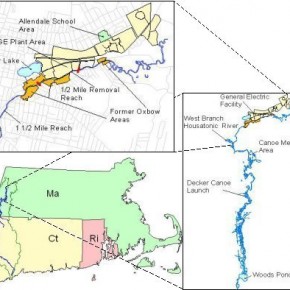
Housatonic River: Two-mile section, top left; Rest of River; right. Click map for a larger image. (Map: EPA)
July 3, 2011
Editor’s Note: The cleanup of the Housatonic River has reached a critical phase. You may remember that in 2000, the Environmental Protection Agency (EPA), the Commonwealth of Massachusetts, Connecticut, and the City of Pittsfield negotiated a consent decree with General Electric (GE) that laid out a clear plan to clean up two miles of the heavily PCB-contaminated portions of the Housatonic River. The parties agreed upon a process to arrive at a cleanup decision for the next long portion of the river south of the confluence of the east and west branches, called the “Rest of the River.”
There is much controversy about how best to clean this portion of the Housatonic. GE has made a slick movie advocating for the “natural recovery” of the river, claiming that a rigorous cleanup would destroy the river to save it — while also claiming that wildlife seem to be flourishing despite any PCBs.
However, the EPA’s peer-reviewed Human Health Risk Assessment and Ecological Risk Assessment show a different picture: A heavily contaminated river that poses a very real threat to public health and the health of the river’s wildlife.
Many parties are attempting to influence the EPA as it tries to figure out a plan for the river. GE’s video has been widely distributed by the Berkshire County League of Sportsmen. The Commonwealth of Massachusetts is pressuring the EPA to endorse a limited cleanup. And recently a new super-agency in Berkshire County — a coalition of the Berkshire Chamber of Commerce, the Berkshire Visitor’s Bureau, and Berkshire Creative — have formed 1Berkshire. The first initiative of 1Berkshire was to form The Smart Cleanup Coalition and try to influence the debate on the Rest of the River. On its Facebook page, the Smart Cleanup Coalition advocates for what it calls “a low-impact clean up of the Housatonic River.”
Although first denying any ties to GE, Michael Daly, the president of Berkshire Bank and one of the founders of both 1Berkshires and the Smart Cleanup Coalition, admitted that 1Berkshire had received $300,000 from GE but he insisted there was no quid pro quo. He insisted that 1Berkshire’s position on the river clean-up, and the launch of the Smart Cleanup Coalition as 1Berkshire’s first public project, was in no way connected to substantial funding from GE.
George Wislocki is the founder of the Berkshire Natural Resources Council and is responsible for protecting thousands of acres of Berkshires land. He is currently on the board of directors of Green Berkshires.
He has given Red Crow News permission to share his letter to Berkshire Bank.
———————-
July 2, 2011
Mr. Michael P. Daly, President
Berkshire Bank
22 West Street
Pittsfield, MA 01201
Dear Mr. Daly,
My wife and I have decided to close out our account with Berkshire Bank. Our decision to do so was prompted by an article which appeared in the Feb. 27th edition of the Boston Globe. The article, written by Globe staff writer Beth Daley, describes Berkshire Bank’s involvement in a scheme concocted by GE publicists to subvert the efforts of the federal Environmental Protection Agency to remediate the Housatonic River. Smart River Clean-Up is nothing more than a foil intended to deflect public attention from GE’s real intention which is to do at best a superficial clean-up of the river.
The bank’s involvement with GE has done a great disservice to the many community groups and organizations who have studied the various remedial options and their impact on the river. That the bank’s operating foundation and 1Berkshires would receive $300,000 from GE does not surprise me; after all the bank and it is board have maintained close ties to GE throughout the years. However, that the bank should be covertly preparing propaganda for the interests of GE seems to me way out of bounds.
Forty years ago when Alice and I opened our account with Berkshire Bank, Jim Sloane was president. I remember very well how he, working with Phil Ahern, the director of the Berkshire County Economic Development Commission, set forth an agenda which brought the Berkshire Regional Planning Commission into being. This was not an easy task, but they did prevail and today the BRPC is a vibrant institution which works for the Berkshires as a whole. Much of its success may be traced to its transparency, open meetings, Town appointed delegates and, most importantly, public forums.
The intentions of 1Berkshires may be quite different from those of the BRPC. However, the autocratic rule which is described in the Globe article may also prove distasteful to many within the educational, cultural and philanthropic communities. The board of 1Berkshires may wish to look more deeply into its structure and governance.
Yours truly,
George S. Wislocki
169 Pomeroy Avenue
Pittsfield, MA 01201
_______________________________________
A comment from a reader in Costa Rica:
And here I thought because I live here in a 3rd world country that is why it is so hard to save the environment, when, if fact, the example put forth by the “developed” countries, and their lack of effort is the real problem. You lead by example. They should be ashamed of themselves. Keep up the good work of exposing them for what they are. It may be that the 3rd world shall be the teachers.
Frankie T.
